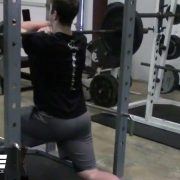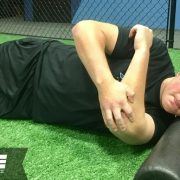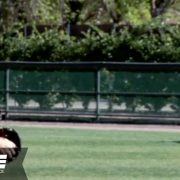Pullover Variations to Improve Overhead Stability in Throwers
When working with overhead athletes, optimal positioning and function of the shoulder complex is vital for sustained performance. Whether you’re a high school outfielder or major league pitcher optimal development and function of the serratus anterior and the deep abdominals are a must for meeting the demands of an overhead sport like baseball. This brings us to the Kettlebell Pullover; this exercise is an underutilized yet effective movement that baseball players can add into their performance and rehabilitation programs.
Why should we use them?
With these exercise variations, we are achieving many things. First, the person will have to stabilize their anterior core while moving their arms in space (AKA proximal stability promoting distal mobility). This allows us to see the person’s ability to reach a full squat both passively (through hip flexion on the floor) as well as actively (reaching a full squat position).
The exercises posted below are challenging the individual to go overhead while maintaining the pelvis and rib cage over one another. This can help achieve proper scapular upward rotation, scapular posterior tilt, and protraction of the scapula.
One of the other benefits is it can be modified to fit the movement ability of each person. As shown below these exercises follow a developmental sequence of supine to half or tall kneeling to standing.
This is a general progression of positions I may follow with a person who has limited movement experience and needs to better solidify their overhead capabilities.
Kettlebell Pullover Variations for Throwers
Progression 1: Supine
The follow supine exercise can be progressed from bilateral to unilateral, and feet on the ground transitioning to a 90/90 position without wall support.
Supine Kettlebell Pullover
Supine Single Arm Kettlebell Pullover
Supine Bottoms Up Single Arm Kettlebell Pullover
Progression 2: Kneeling
The following exercises progress from half kneeling or tall kneeling, can be performed bilateral or unilateral, and can go from a light band to a light Kettlebell.
Tall Kneeling Bilateral Band Pullover
Half Kneeling Single Arm Kettlebell Pullover
Progression 3: Standing
Lastly, we can progress to the standing position, with or without the squat.
Kettlebell Goblet Squat with Heartbeat to Pullover
Application to Strength Training
These exercises are beneficial for the overhead athlete in both the warm up and during the workout itself. These exercises teach the client how to keep their pelvis and rib cage aligned, which will then carry over to relearning a more optimal overhead mechanical pattern.
When progressed appropriately it can also be a challenging anterior core exercise because the person has to resist excessive lumbar extension while their arms begin to move overhead.
Application to Rehabilitation
Many times patients come to us with hip and shoulder pains that can be traced back to overuse of the latissimus dorsi and underuse of the deep abdominal muscles, serratus anterior along with an anteriorly tilted pelvis. When we begin to balance out these opposing forces, we then see better outcomes in our patient population.
These exercises are a good starting point to slowly and safely reintroduce the overhead pattern in various non-threatening positions. Many times a patient is highly guarded after experiencing shoulder soreness or an injury. Putting them in these positions allows the therapist to tap into the person’s nervous system and make a positive change towards the patient relearning a more optimal overhead movement sequence.
Finally, it gives us a global view of the person we are working with. Can they do the task we want or do they need an excessive amount of extension strategies to get into the squat position or to get their arms fully overhead?
How to Program
Start with 2-4 sets of 4-6 breaths either in the warm up or as filler in between exercises is a great place to begin implementing this exercise.
- Reach your arms long to the ceiling throughout the motion
- Inhale to start the motion and exhale as you bring the Kettlebell down towards the floor
- Slightly bring your belt buckle towards your chin while maintaining your low back on the floor










Trackbacks & Pingbacks
[…] a flat bench. As with most other best back exercises out there, you can opt for different dumbbell pull-over variations that will help grow your […]
Leave a Reply
Want to join the discussion?Feel free to contribute!